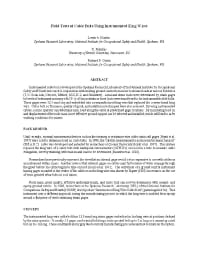Mining Publication: Field Tests of Cable Bolts Using Instrumented King Wires
Original creation date: March 2000
Authors: LA Martin, R Pakalnis, RP Curtin
NIOSHTIC2 Number: 20021238
Presentation at the Canadian Institute of Mining, Metallurgy, and Petroleum--CIM 2000 Meeting, 2000, Mar 5-10 Toronto, Ontario, Canada :1-10
Instrumented cable bolts developed at the Spokane Research Laboratory of the National Institute for Occupational Safety and Health were used in conjunction with existing ground control to monitor rock mass loads at various field sites (T.G. Soda Ash, Getchell, Meikle, SSX, K-2, and Stillwater). Axial and shear loads were determined by strain gages to levels of instrument accuracy of ±5 N or ±5 microstrain as these loads were transferred to the instrumented cable bolts. These gages were 12.5 mm long and embedded into a remanufactured king wire that replaced the conventional king wire. Cable bolt performance, quality of grout, and installation techniques were also assessed. By using instrumented cables, a mine operator can determine axial load along the cable at predefined gage locations. By monitoring load on and displacement of the rock mass, more effective ground support can be selected and installed, which will lead to safer working conditions for miners.

NIOSHTIC2 Number: 20021238
Presentation at the Canadian Institute of Mining, Metallurgy, and Petroleum--CIM 2000 Meeting, 2000, Mar 5-10 Toronto, Ontario, Canada :1-10
- 60 Years of Rockbursting in the Coeur D'Alene District of Northern Idaho, USA: Lessons Learned and Remaining Issues
- Comparison of Ground Conditions and Ground Control Practices in the United States and Australia
- Determination of In Situ Deformation Modulus for Cemented Rockfill
- Dynamic Failure in Deep Coal: Recent Trends and a Path Forward
- Evaluation of Instrumented Cable and Rebar Bolts as Ground Support at a Trona Mine
- Horizontal Stress and Longwall Headgate Ground Control
- Numerical Model Calibration for Simulating Coal Pillars, Gob and Overburden Response
- Roof Screening for Underground Coal Mines: Recent Developments
- Updating the NIOSH Support Technology Optimization Program (STOP) With New Support Technologies and Additional Design Features
- Variation of Horizontal Stresses and Strains in Mines in Bedded Deposits in the Eastern and Midwestern United States